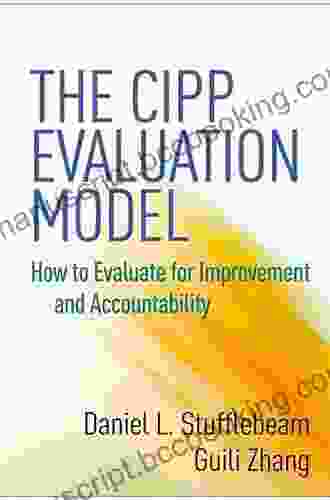How to Evaluate for Improvement and Accountability: The Ultimate Guide to Empowering Your Team and Achieving Results

In today's competitive business landscape, organizations that prioritize improvement and accountability stand head and shoulders above the rest. Effective evaluation serves as the cornerstone of this success, providing a structured framework for assessing performance, identifying areas for growth, and fostering a culture of continuous improvement.
This comprehensive guide will delve into the intricacies of evaluation for improvement and accountability, empowering you with the tools and strategies to:
- Set clear expectations and objectives
- Measure progress towards defined goals
- Provide constructive feedback and support
- Drive performance improvement
- Enhance communication and collaboration
- Cultivate a culture of accountability and ownership
Evaluation is not merely about assigning grades or passing judgments. It is a transformative process that empowers individuals and teams to:
4.7 out of 5
| Language | : | English |
| File size | : | 8147 KB |
| Screen Reader | : | Supported |
| X-Ray | : | Enabled |
| Print length | : | 384 pages |
| X-Ray for textbooks | : | Enabled |
- Gain self-awareness: By understanding their strengths and areas for improvement, individuals can proactively identify opportunities for growth and development.
- Enhance motivation: Clear evaluations and expectations provide a roadmap for success, motivating individuals to strive for excellence and exceed expectations.
- Improve communication: Effective evaluation fosters open and honest dialogue between employees and supervisors, facilitating the sharing of insights and the development of collaborative solutions.
- Build trust: When evaluations are conducted fairly and transparently, trust between employees and management grows, creating a positive and supportive work environment.
- Drive organizational success: By continuously evaluating and improving performance, organizations can identify and address challenges early on, adapt to changing market conditions, and achieve sustainable growth.
The foundation of effective evaluation lies in establishing clear performance expectations. This involves:
- Defining performance goals: Collaborate with employees to set specific, measurable, achievable, relevant, and time-bound (SMART) goals.
- Communicating expectations: Clearly articulate performance expectations, ensuring that employees fully understand their roles and responsibilities.
- Providing resources and support: Equip employees with the necessary resources and support to achieve their goals effectively.
Regularly tracking progress towards performance goals is crucial to assess improvement and identify areas for further development. This involves:
- Establishing performance metrics: Determine appropriate metrics that accurately measure progress towards established goals.
- Collecting data: Gather data through regular observations, self-assessments, and other objective sources.
- Analyzing results: Interpret data to identify trends, patterns, and areas where performance can be improved.
Constructive feedback is essential for promoting growth and development. It should be:
- Specific: Provide specific examples of strengths and areas for improvement.
- Actionable: Offer clear suggestions on how to address areas for improvement.
- Timely: Provide feedback promptly to ensure maximum impact.
- Delivered in a supportive manner: Focus on providing guidance and support rather than criticism.
Creating a culture of continuous improvement ensures that individuals and teams are constantly striving for excellence. This involves:
- Setting stretch goals: Encourage employees to push boundaries and set challenging yet achievable goals.
- Providing ongoing learning opportunities: Offer training, workshops, and other opportunities for employees to develop new skills and knowledge.
- Celebrating successes: Recognize and reward employees for their achievements, fostering motivation and a sense of accomplishment.
Effective evaluation requires open and transparent communication between employees and supervisors. This involves:
- Regular check-ins: Schedule regular meetings to discuss performance, provide feedback, and address any challenges.
- Creating a safe space for feedback: Encourage employees to share concerns, ask questions, and provide input on their evaluation process.
- Fostering collaboration: Facilitate teamwork and peer support to enhance knowledge sharing and problem-solving.
Accountability is essential for driving performance improvement and ensuring that individuals take ownership of their actions. This involves:
- Setting clear roles and responsibilities: Define the specific roles and responsibilities of each individual or team.
- Empowering employees: Provide employees with the authority and autonomy to make decisions and take initiative.
- Hold individuals accountable: Clearly communicate performance expectations and consequences for failing to meet them.
Mastering the art of evaluation for improvement and accountability transforms organizations into high-performing powerhouses. By empowering teams, setting clear expectations, measuring progress, providing constructive feedback, encouraging continuous improvement, enhancing communication, and cultivating a culture of accountability, you can unlock the potential of your team and achieve extraordinary results. Embrace the principles outlined in this guide and witness the transformative power of effective evaluation.
Invest in the future of your organization and Free Download your copy of "How to Evaluate for Improvement and Accountability" today. Empower your team, drive performance, and achieve transformative results. Every Free Download includes exclusive access to downloadable templates, resources, and tools to support your evaluation journey. Don't wait, Free Download now and unlock the secrets to organizational success!
4.7 out of 5
| Language | : | English |
| File size | : | 8147 KB |
| Screen Reader | : | Supported |
| X-Ray | : | Enabled |
| Print length | : | 384 pages |
| X-Ray for textbooks | : | Enabled |
Do you want to contribute by writing guest posts on this blog?
Please contact us and send us a resume of previous articles that you have written.
 Book
Book Novel
Novel Page
Page Chapter
Chapter Text
Text Story
Story Genre
Genre Reader
Reader Library
Library Paperback
Paperback E-book
E-book Magazine
Magazine Newspaper
Newspaper Paragraph
Paragraph Sentence
Sentence Bookmark
Bookmark Shelf
Shelf Glossary
Glossary Bibliography
Bibliography Foreword
Foreword Preface
Preface Synopsis
Synopsis Annotation
Annotation Footnote
Footnote Manuscript
Manuscript Scroll
Scroll Codex
Codex Tome
Tome Bestseller
Bestseller Classics
Classics Library card
Library card Narrative
Narrative Biography
Biography Autobiography
Autobiography Memoir
Memoir Reference
Reference Encyclopedia
Encyclopedia Sabine Kranich
Sabine Kranich Grant Petersen
Grant Petersen Hal Roth
Hal Roth Rob Biesenbach
Rob Biesenbach King Heiple
King Heiple Ivan M Illan
Ivan M Illan Herbert Feigl
Herbert Feigl Farah Ali
Farah Ali John D Gordon
John D Gordon Melissa Leapman
Melissa Leapman Ty Seidule
Ty Seidule Sid Waddell
Sid Waddell Joyce Miller
Joyce Miller Felicity Aston
Felicity Aston Ira K Wolf
Ira K Wolf Robert Alan Brookey
Robert Alan Brookey Richard Kaczynski
Richard Kaczynski Werner Plumpe
Werner Plumpe Frances F Dunwell
Frances F Dunwell Patricia B Mcconnell
Patricia B Mcconnell
Light bulbAdvertise smarter! Our strategic ad space ensures maximum exposure. Reserve your spot today!
 Steven HayesFollow ·9.5k
Steven HayesFollow ·9.5k Houston PowellFollow ·7.5k
Houston PowellFollow ·7.5k Brett SimmonsFollow ·7.9k
Brett SimmonsFollow ·7.9k Rex HayesFollow ·13.7k
Rex HayesFollow ·13.7k Aldous HuxleyFollow ·15.2k
Aldous HuxleyFollow ·15.2k Jayden CoxFollow ·17.8k
Jayden CoxFollow ·17.8k Ibrahim BlairFollow ·5.9k
Ibrahim BlairFollow ·5.9k W.H. AudenFollow ·5.4k
W.H. AudenFollow ·5.4k

 W.H. Auden
W.H. AudenStep into a World of Thrilling Deception: Don Blink by...
Unveiling the Masterpiece of Suspense:...

 Jaylen Mitchell
Jaylen MitchellUnleash Your Creativity with "This Easy Origami": A...
: Embark on an Enchanting Voyage into the...

 Vladimir Nabokov
Vladimir NabokovEmpowering Home Births: A Comprehensive Guide for Fathers...
An In-Depth Exploration of Paternal...

 Juan Rulfo
Juan RulfoThe Maya Exodus: Indigenous Struggle for Citizenship in...
The Maya Exodus: Indigenous Struggle for...

 Julio Ramón Ribeyro
Julio Ramón RibeyroKana Made Easy: Dive into Japanese the Fun and Effortless...
Unveiling the Secrets...
4.7 out of 5
| Language | : | English |
| File size | : | 8147 KB |
| Screen Reader | : | Supported |
| X-Ray | : | Enabled |
| Print length | : | 384 pages |
| X-Ray for textbooks | : | Enabled |














